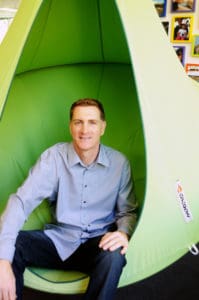Home remodeling online marketplace Houzz.com is growing its business through advanced technology that makes it easier for consumers to see products in their homes and by launching websites around the world.
Houzz now operates websites in 14 countries outside of the United States—11 in Europe, plus Japan, Singapore and India, and all provide free listing to contractors, architects, designers and other professionals. Twelve of those sites also enable those professionals to advertise their services to homeowners in their markets, president and co-founder Alon Cohen said today in a keynote address at the Internet Retailer Conference & Exhibition in Chicago. Cohen said 3% of projects received by design pros via Houzz in 2017 were from outside their own country, and Houzz drove $4 billion worth of business last year to paying companies.
Some 1.5 million home remodeling service providers in 65 categories are listed on Houzz.com, which attract 40 million unique visitors per month. Houzz provides free listings for those professionals and earns revenue by displaying ads from professionals seeking projects in their areas.
Technology that makes it easier to visualize products in their home also has boosted sales on Houzz.com, which offers more than 10 million home décor products and furniture from 20,000 retailers. Houzz.com is No. 10 in Internet Retailer’s 2018 Online Marketplaces ranking.

Alon Cohen, co-founder and president, Houzz
Cohen says letting consumers see three-dimensional images of products in their homes has increased conversion in a big way. Consumers using Houzz mobile apps can view 1 million products as 3-D images—up from 300,000 when the 3-D feature was added last year—and 2 million consumers have used the visualization tool when making purchases, Cohen said. They also can add notes to their images and share them with others. He said those who view 3-D images of products are 11-times more likely to purchase than website visitors who don’t.
Personalization also increases the likelihood that a site visitor will buy. Cohen showed an example of a barstool product page with recommendations of related products. He said that while 38% of consumers who land on this product page buy the barstool, 62% buy at least one of the recommended products.
Houzz tailors the recommendations to each consumer, using such data as the consumer’s style preferences, what kind of photos they save and other products that were in photos they viewed.
A new feature in the Houzz app lets a consumer turn a tablet into a photograph of a product, letting a consumer hold, for example, an image of a piece of art or lighting element on a wall to see how it would look in her home.
Cohen said features like that make purchasing home goods online in some ways better than shopping in a store.
“If you want to buy a sofa and want to see what it will look like in your home, you can do that with your phone, but you can’t do that in a store,” he said. “It’s getting to where e-commerce provides a better customer experience than the offline experience.”
Cohen, who co-founded Houzz in 2009 with Houzz CEO and Cohen’s wife Adi Tatarko, did not address speculation Houzz may be preparing to go public prompted by the company’s recent hiring of a chief financial officer from LinkedIn Corp. Houzz has raised $613.6 million in funding, according to Crunchbase, and is reportedly valued at $4 billion.
Cohen said 90% of Houzz users are homeowners, and that 84% of those homeowners plan to purchase a home product in the next six months and 71% plan to renovate or redecorate their home.
Favorite